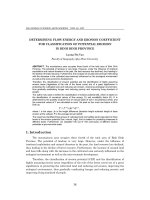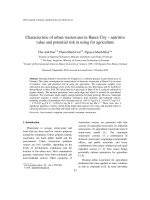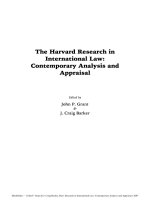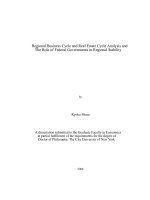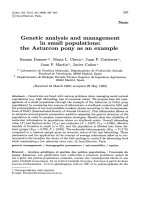Potential biases in the classification, analysis and interpretations in cross-sectional study: Commentaries – surrounding the article “resting heart rate: Its correlations and potential for
Bạn đang xem bản rút gọn của tài liệu. Xem và tải ngay bản đầy đủ của tài liệu tại đây (232.38 KB, 4 trang )
de Moraes et al. BMC Pediatrics 2014, 14:117
/>
COMMENTARY
Open Access
Potential biases in the classification, analysis
and interpretations in cross-sectional study:
commentaries – surrounding the article “resting
heart rate: its correlations and potential for
screening metabolic dysfunctions in adolescents”
Augusto César Ferreira de Moraes1,2*†, Alex Jones Flores Cassenote3†, Luis A Moreno2,4 and Heráclito Barbosa Carvalho1
Abstract
Background: Resting heart rate reflects sympathetic nerve activity. A significant association between resting heart
rate (HR) and all causes of cardiovascular mortality has been reported by some epidemiologic studies. Despite
suggestive evidence, resting heart rate (RHR) has not been formally explored as a prognostic factor and potential
therapeutic outcome and, therefore, is not generally accepted in adolescents.
Discussion: The core of the debate is the methodological aspects used in “Resting heart rate: its correlations
and potential for screening metabolic dysfunctions in adolescents”; the points are: cutoff used for cluster RHR,
two different statistical models used to analyze the same set of variables, one for continuous data, and another for
categorical data; interpretation of p-value < 0.05, sampling process involving two random stages, analysis of design
effect and the parameters of screening tests.
Summary: Aspects that must be taken into account for evaluation of a screening test to measure the potential for
discrimination for a common variable (population with outcome vs. no outcome population), the main indicators
are: sensitivity, specificity, accuracy, positive predictive value and negative predictive value. The measures of
argumentation equality (CI) or difference (p-valor) are important to validate these indicators but do not indicate
quality of screening.
Keywords: Resting heart rate, Screening test, P-value, High glucose, High triglycerides
Background
Recently, Fernandes et al. published an article aimed at
analyzing the potential effects of screening and resting
heart rate (RHR) on cardiometabolic risk in adolescents
[1] in this respected journal. We read the manuscript
with great interest, since RHR reflects sympathetic nerve
activity [2,3], and it is an easily accessible clinical
measurement. A significant association between resting
* Correspondence:
†
Equal contributors
1
Department of Preventive Medicine, School of Medicine of the University of
São Paulo, São Paulo, SP, Brazil
2
GENUD - Growth, Exercise, Nutrition and Development, UNIZAR/Spain,
Zaragoza, Spain
Full list of author information is available at the end of the article
HR and all-causes of cardiovascular mortality has been
reported in some epidemiological studies [2,4-6].
After studying the article, we decided to take the
opportunity to propose a healthy debate on the methodological aspects used by Fernandes et al. [1]. With this
debate, we hope to contribute to the enrichment of the
reader, especially with regard to statistical analysis and
interpretation of results.
The aim of this article is to present a critical appraisal of
methodological aspects of the article “Resting heart rate:
its correlations and potential for screening metabolic dysfunctions in adolescents” presented by BMC Pediatrics.
© 2014 de Moraes et al.; licensee BioMed Central Ltd. This is an Open Access article distributed under the terms of the
Creative Commons Attribution License ( which permits unrestricted use,
distribution, and reproduction in any medium, provided the original work is properly credited.
de Moraes et al. BMC Pediatrics 2014, 14:117
/>
Discussion
First, with regard to the manuscript methodology, what
drew our attention was the cutoff used for cluster RHR.
We see that the authors used cutoffs developed by the
group of the first author (Fernandes RA) [7]. These cutoff points were developed by percentile distribution of a
sample composed only of children and adolescent males
and the study published in this journal is composed only
of adolescents of both sexes. This decision introduced
classification bias into the study, though it was not recognized as a study limitation: children are biologically
different than adolescents because they have not gone
through puberty, and there are important and significant
differences between the sexes concerning the cardiovascular system [8].
Boys had higher pooled prevalence than girls [9,10].
There are possible explanations for differences between
the sexes: 1) the boys had a higher accumulation of
visceral fat and intra-abdominal fat than girls [11], and
visceral fat has been associated with higher sympathetic
activity [12,13] This activation is a key mechanism underlying the effect of intra-abdominal fat accumulation
on the development of hypertension [14]. For example,
increased sympathetic flow may increase sodium reabsorption and subsequent increased peripheral vascular
resistance resulting in increased blood pressure [14]. Also,
this increased sympathetic activation can be caused by
increased testosterone concentrations in males. Testosterone, acting as a mediator of the androgen receptor gene
function [15], has been associated not only with increased
visceral fat but also with greater vasomotor sympathetic
tone and blood pressure in adolescent boys, compared to
girls [16]. Therefore, we believe that the cutoffs used are
not appropriate for the above and highlight the need for
the scientific community to develop better diagnostic
criteria and methodological quality appropriate for each
sex and age of this important indicator of the cardiovascular system.
According to the title of the article, the authors’ objective was to analyze the impact of RHR for screening metabolic dysfunctions and also to identify its significance in
adolescents.. For this, they used two different statistical
models in order to analyze the same set of variables, one
for continuous data, and another for categorical data. We
found this odd, since assumptions for statistical models
are quite distinct (binary logistic regression model vs. linear regression model). So we raise the following questions:
“Were the linear models used because no association was
found with categorical variables? Why were the two models
used? Why analyze variables with continuous data and
then analyze these variables with categorical data, sequentially?” We performed these questions, because according
the objectives; the authors wanted determine the correlation between RHR and metabolic dysfunctions and also
Page 2 of 4
the potential power of screening the RHR. What is not
clear is the use of logistic regression to meet those aims.
In some instances we recommended that the authors state
why they have used these tests and provide a reference for
a definitive description for readers [17].
With regard to OR estimates using binary logistic
regression, the literature shows that the use of OR (estimated with logistic regression) as a measure of effect in
the cross-sectional studies has limitations: OR overestimates RP/RR according to increases of prevalence/incidence of outcome; between 5% and 10% OR has good
approximation with RP/RR, after that the risk value is
very distorted and it serves more to show the association
direction (risk or protection) and not its magnitude; this
topic was widely discussed in the nineties by experts
[18-20], and confirms that OR overestimates the magnitude of the associations between exposures and outcomes,
particularly in high prevalence [21,22]. The mathematical
model for logistic regression was developed in the 1970s
and 1980s to analyze case–control studies and used as a
proxy for relative risk [23,24], where it is not possible to
estimate prevalence, another important methodological
factor neglected by the authors.
The authors say they used a sampling process involving
two random stages (schools in the first stage and individual classes in the second stage), but give no further details
of this process, for example, whether the complex sample
has good accuracy. When using complex samples the
design effect (deff) helps to estimate how accurate the
sample was [25-27]. When the sampling process is not accurate the analyses need to be adjusted for the complexity
of the sample, and the lack of this setting also impacts the
associations [28]. Therefore, the impact of risk factors
estimated by the logistic models, even without statistical
significance, may not be exactly the absence shown by
adjusting the primary sampling unit.
We found the use of RHR to screen for alterations
in glucose and triglycerides interesting but, according
to the data presented, we believe that there is no evidence for this. Accuracy (AUC) for high glucose was
0.611 (95% CI 0.534–0.688) and high triglycerides,
0.618 (95% CI 0.531–0.705), both with p-values < 0.05, but
with low discrimination power—note the lower confidence bound in some cases is very close to 0.50
(random event). In other words, if we consider random variations within the CI bounds of AUC, determining the presence or absence of high glucose and
high triglycerides will be as precise as playing a game
of heads or tails. With regard to the accuracy of results, Swets [29] suggested operational cut-off points:
the test can be non-informative/test equal to chance
(0.5AUC < 0.7); moderately accurate (0.7 > AUC ≤ 0.9);
highly accurate (0.9 > AUC < 1.0); and perfect discriminatory tests (AUC = 1.0).
de Moraes et al. BMC Pediatrics 2014, 14:117
/>
Nowadays a “p-value < 0.05” or significant association is
commonly employed to illustrate the importance of latest
scientific finding. We emphasize, however, that statistical
significance is neither a necessary nor a sufficient condition for proving a scientific result [30]. P-values are often
used to emphasize the certainty of data, but they are only
a passive read-out of a statistical test and do not take into
account how well an experiment was designed, for
example [31]. Goodman [32], in his “The P Value Fallacy”
explains about the apparent inconsistency in much medical research, where by studies are designed according to a
Neyman-Pearson statistical approach (eg. based on formal
decision making and long-run evaluation of the inferential
procedures), fixing statistical parameters as significance
level and power, but are then analyzed by using a Fisherian
point of view (eg. computing p-values and making inference based on its value, in comparison to common
thresholds).
We must remember that the screening is conceptually
defined as tests performed on apparently healthy people
to identify those at an increased risk of a disease or
disorder [33]. According to the literature, for screening
to be accurate, a good screening test must have high
sensitivity (few false-negative results) and a high specificity (few false-positive results) [34] and even very good
tests have poor positive predictive value when applied to
low-prevalence populations [35].
We would like to emphasize that Fernandes et al. [1]
have provided an important scientific contribution with
their study on RHR, and that criticism is an integral part
of scientific progress. As the pediatrician John Locke said,
“…every step the mind takes in its progress towards knowledge makes some discovery, which is not only new, but
the best too, for the time at least”.
Summary
The main indicators that must be taken into account for
evaluation of a screening test to measure the potential
for discrimination for a common variable (population
with outcome vs. no outcome population) are: sensitivity, specificity, accuracy, positive predictive value and
negative predictive value. The measures of argumentation equality (CI) or difference (p-valor) are important
to validate these indicators but do not indicate quality of
screening.
We believe the statistical methodologies employed in
support of science should consider the objectives of the
paper, type of data available (with the least possible
transformations) and statistical assumptions in order to
answer scientific hypotheses. The interpretation of
statistical data has to be made very carefully, otherwise
science loses its footing and becomes a relentless pursuit
of the “p-value < 0.05”.
Page 3 of 4
Abbreviations
RHR: Resting heart rate; HR: Heart rate; p-value: Descriptive level; deff: Design
effect; CI: Confidence interval; AUC: Accuracy.
Competing interests
The remaining authors state no competing interest.
Authors’ contributions
ACFM and AJFC made substantial contributions to the conception and
interpretation of the material; ACFM, HBC, AJFC, LAM were involved in
drafting the manuscript and revising it critically for important intellectual
content and approval of the version to be published.
Author details
1
Department of Preventive Medicine, School of Medicine of the University of
São Paulo, São Paulo, SP, Brazil. 2GENUD - Growth, Exercise, Nutrition and
Development, UNIZAR/Spain, Zaragoza, Spain. 3Postgraduate Program in
Infectious and Parasitic Diseases, School of Medicine of the University of São
Paulo, São Paulo, SP, Brazil. 4Faculty of Health Sciences of the University of
Zaragoza, Zaragoza, Spain.
Received: 22 July 2013 Accepted: 25 April 2014
Published: 3 May 2014
References
1. Fernandes RA, Vaz Ronque ER, Venturini D, Barbosa DS, Silva DP, Cogo CT,
Carnelossi MS, Batista MB, Coelho-E-Silva MJ, Sardinha LB, Cyrino ES: Resting
heart rate: its correlations and potential for screening metabolic
dysfunctions in adolescents. BMC Pediatr 2013, 13(1):48.
2. Bemelmans RH, van der Graaf Y, Nathoe HM, Wassink AM, Vernooij JW,
Spiering W, Visseren FL, group obotSs: The risk of resting heart rate on
vascular events and mortality in vascular patients. Int J Cardiol 2013,
168(2):1410–1415.
3. Grassi G, Vailati S, Bertinieri G, Seravalle G, Stella ML, Dell’Oro R, Mancia G:
Heart rate as marker of sympathetic activity. J Hypertens 1998,
16(11):1635–1639.
4. Jouven X, Empana JP, Schwartz PJ, Desnos M, Courbon D, Ducimetière P:
Heart-rate profile during exercise as a predictor of sudden death.
N Engl J Med 2005, 352(19):1951–1958.
5. Palatini P, Julius S: Elevated heart rate: a major risk factor for
cardiovascular disease. Clin Exp Hypertens 2004, 26(7–8):637–644.
6. Pocock SJ, Wang D, Pfeffer MA, Yusuf S, McMurray JJ, Swedberg KB,
Ostergren J, Michelson EL, Pieper KS, Granger CB: Predictors of mortality
and morbidity in patients with chronic heart failure. Eur Heart J 2006,
27(1):65–75.
7. Fernandes RA, Freitas Júnior IF, Codogno JS, Christofaro DG, Monteiro HL,
Roberto Lopes DM: Resting heart rate is associated with blood pressure
in male children and adolescents. J Pediatr 2011, 158(4):634–637.
8. Spear B: Children and Adolescent Grrowth and Development. In
Adolescent Nutrition: Assessment and Management. Volume 1st edition.
Edited by Rickert V. New York: Chapman & Hall Publishing; 1995.
9. Muntner P, He J, Cutler JA, Wildman RP, Whelton PK: Trends in blood
pressure among children and adolescents. J Am Med Assoc 2004,
291(17):2107–2113.
10. Ostchega Y, Carroll M, Prineas RJ, McDowell MA, Louis T, Tilert T: Trends of
elevated blood pressure among children and adolescents: data from
the national health and nutrition examination survey 1988–2006.
Am J Hypertens 2009, 22(1):59–67.
11. Pausova Z, Mahboubi A, Abrahamowicz M, Leonard GT, Perron M, Richer L,
Veillette S, Gaudet D, Paus T: Sex differences in the contributions of
visceral and total body fat to blood pressure in adolescence.
Hypertension 2012, 59(3):572–579.
12. Esler M, Straznicky N, Eikelis N, Masuo K, Lambert G, Lambert E:
Mechanisms of sympathetic activation in obesity-related hypertension.
Hypertension 2006, 48(5):787–796.
13. Alvarez GE, Beske SD, Ballard TP, Davy KP: Sympathetic neural activation in
visceral obesity. Circulation 2002, 106(20):2533–2536.
14. Huggett RJ, Burns J, Mackintosh AF, Mary DA: Sympathetic neural
activation in nondiabetic metabolic syndrome and its further
augmentation by hypertension. Hypertension 2004, 44(6):847–852.
de Moraes et al. BMC Pediatrics 2014, 14:117
/>
Page 4 of 4
15. Weise M, Eisenhofer G, Merke DP: Pubertal and gender-related changes in
the sympathoadrenal system in healthy children. J Clin Endocrinol Metab
2002, 87(11):5038–5043.
16. Pausova Z, Abrahamowicz M, Mahboubi A, Syme C, Leonard GT, Perron M,
Richer L, Veillette S, Gaudet D, Paus T: Functional variation in the
androgen-receptor gene is associated with visceral adiposity and blood
pressure in male adolescents. Hypertension 2010, 55(3):706–714.
17. Greenhalgh T: How to read a paper. Statistics for the non-statistician. I:
different types of data need different statistical tests. BMJ 1997,
315(7104):364–366.
18. Lee J, Chia KS: Estimation of prevalence rate ratios for cross sectional
data: an example in occupational epidemiology. Br J Ind Med 1993,
50(9):861–862.
19. Axelson O, Fredriksson M, Ekberg K: Use of the prevalence ratio v the
prevalence odds ratio as a measure of risk in cross sectional studies.
Occup Environ Med 1994, 51(8):574.
20. Axelson O, Fredriksson M, Ekberg K: Use of the prevalence ratio v the
prevalence odds ratio in view of confounding in cross sectional studies.
Occup Environ Med 1995, 52(7):494.
21. Barros AJ, Hirakata VN: Alternatives for logistic regression in cross-sectional
studies: an empirical comparison of models that directly estimate the
prevalence ratio. BMC Med Res Methodol 2003, 3:21.
22. Polderman J, Gurgel RQ, Barreto-Filho JAS, Roelofs R, Ramos REDO,
De Munter JS, Wendte JF, Agyemang C: Blood pressure and BMI in
adolescents in Aracaju, Brazil. Public Health Nutri 2011, 14(6):1064–1070.
23. Breslow N, Day N: Statistical Methods in Cancer Research. The Analysis of
Case–Control Studies. Lyon: IARC Scientific Publications; 1980.
24. Schlesselman J: Case–Control Studies: Design, Conduct, Analysis. New York:
Oxford University Press; 1982.
25. Kish L: Survey Sampling. New York: John Wiley & Sons; 1965.
26. Korn EL, Graubard BI: Epidemiologic studies utilizing surveys: accounting
for the sampling design. Am J Public Health 1991, 81(9):1166–1173.
27. Heo M, Kim Y, Xue X, Kim MY: Sample size requirement to detect an
intervention effect at the end of follow-up in a longitudinal cluster
randomized trial. Stat Med 2010, 29(3):382–390.
28. Barros A, Bertoldi A: Inequalities in utilization and access to dental
services: a nationwide assessment. Cien Saude Colet 2002, 7(4):709–717.
29. Swets JA: Measuring the accuracy of diagnostic systems. Science 1988,
240:1285–1293.
30. Brumfiel B: Significant adjective. Nature 2008, 455(7216):1027–1028.
31. Ziliak S, Mccloskey D: The Cult of Statistical Significance: How the Standard
Error Costs Us Jobs, Justice, and Lives: University of Michigan Press; 2008.
32. Goodman SN: Toward evidence-based medical statistics. 1: the P value
fallacy. Ann Intern Med 1999, 130(12):995–1004.
33. Cuckle H: Principles of screening. Obstetr Gynaecol 2004, 6(1):21–25.
34. Nielsen C, Lang RS: Principles of screening. Med Clin North Am 1999,
83(6):1323–1337. v.
35. Grimes DA, Schulz KF: Uses and abuses of screening tests. Lancet 2002,
359(9309):881–884.
doi:10.1186/1471-2431-14-117
Cite this article as: de Moraes et al.: Potential biases in the classification,
analysis and interpretations in cross-sectional study: commentaries –
surrounding the article “resting heart rate: its correlations and potential
for screening metabolic dysfunctions in adolescents”. BMC Pediatrics
2014 14:117.
Submit your next manuscript to BioMed Central
and take full advantage of:
• Convenient online submission
• Thorough peer review
• No space constraints or color figure charges
• Immediate publication on acceptance
• Inclusion in PubMed, CAS, Scopus and Google Scholar
• Research which is freely available for redistribution
Submit your manuscript at
www.biomedcentral.com/submit
